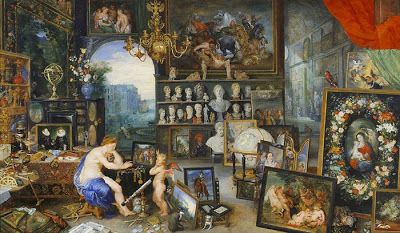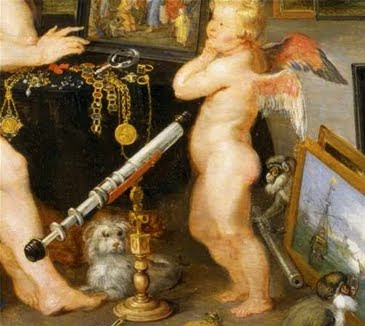Philosophy
 Extensive Landscape with View of the Castle of Mariemont
Extensive Landscape with View of the Castle of Mariemont
Jan Brueghel the Elder
1617

Technology Review
Massachusetts Institute of Technology
October 2nd, 2009
It's hard to find an invention more emblematic of the birth of modern science than the telescope. And yet surprisingly little is known about its early development. The inventor of the telescope remains unknown to this day.
Now a study of the paintings of Jan Brueghel the Elder, a Flemish painter of the Baroque era who was working in Amsterdam at the beginning of the 17th century, is throwing some light on the early development of the telescope. It has also uncovered a mystery, say Paolo Molaro and Pierluigi Selvelli at the Istituto Nazionale di Astrofisica in Trieste. One of Brueghel's works appears to show a Keplerian-style telescope in a painting dating from 15 years before this design was thought to have been built.
Although various writers in the 16th century describe glasses that can "recognize a man from several miles away," the early exploitation of this idea is credited to the Dutch lens maker Hans Lippershey, who in 1608 applied for a patent for a device "for seeing things far away as if they were nearby." However, his application was rejected, apparently because the idea was already well known.
Molaro and Selvelli, who have studied the telescopes depicted in five paintings by Brueghel, say that Lippershey is known to have given one of his earliest instruments to Archduke Albert VII of Habsburg, who had a keen interest in natural philosophy.
That's significant because Brueghel was Albert's court painter. Molaro and Selvelli say that the spyglass depicted in Brueghel's "Extensive Landscape with View of the Castle of Mariemont," dated 1608-1612, is the first painting of a telescope ever made. They go further and speculate that this instrument is the one given to Albert by Lippershey.
The earliest telescopes consisted of a convex objective lens and a concave eyepiece. But Johannes Kepler suggested in 1611 that a better design would have a convex eyepiece. The advantage is a larger field of view and greater relief for the eye, which needn't be placed so close to the eyepiece. The disadvantage, which astronomers eventually came to live with, is that the image is inverted.
Kepler's design wasn't built until much later. The first reference to such an instrument appears in 1631. But here's a mystery: Molaro and Selvelli speculate that a telescope in "The Allegory of Sight," a collaboration between Brueghel and Pierre Paul Rubens dating from 1617, is actually Keplerian (see picture above).
The evidence is twofold. First is the length of the instrument: Molaro and Selvelli estimate that the extended instrument would be some 180 cm or so long. Keplerian designs are longer than the earlier Galilean designs (a misnomer, since Galileo did not invent them). Second is the size of the eyepiece, which appears to limit how close the eye can get to the eyepiece lens. That would only make sense in a Keplerian design.
The question then is who built this telescope, and what was it used for. Keplerian designs can achieve much higher magnifications than their Galilean cousins. That would have given its owner a significant advantage over anyone else scanning the heavens.
If they'd troubled to look, that is. Could it be that the owner of one of the most powerful telescopes on the planet failed to point it skywards? And in failing to do so, missed a chance at the kind of scientific immortality that Galileo was later to achieve?
Abstract:
Several early spyglasses are depicted in five paintings by Jan Brueghel the Elder completed between 1608 and 1625, as he was court painter of Archduke Albert VII of Habsburg. An optical tube that appears in the Extensive Landscape with View of the Castle of Mariemont, dated 1608-1612, represents the first painting of a telescope whatsoever. We collected some documents showing that Albert VII obtained spyglasses very early directly from Lipperhey or Sacharias Janssen. Thus the painting likely reproduces one of the first man-made telescopes ever. Two other instruments appear in two Allegories of Sight made in the years 1617 and 1618. These are sophisticated instruments and the structure suggests that they may be keplerian, but this is about two decades ahead this mounting was in use.
"The Mystery of the Telescopes in Jan Brueghel the Elder's Paintings" by P. Molaro and P. Selvelli
- Self-perception Via The Telescope
"Gaze Upon the Internet's First Telescope Archive" by Ben Richmond February 20th, 2014 Motherboard There has never been an object that changed humanity’s self-perception as quickly or as completely as the telescope. It’s almost impossible to...
- Hans Lippershey...dutch Lens Grinder
Hans Lippershey 1570 to September 1619 Hans Lippershey is part of the debate concerning the one who introduced the telescope...some say Galileo and some say Lippershey. Hans Lippershey was a lens grinder and one anecdote goes: Lippershey was "observing...
- "400 Years Of The Telescope" On Pbs This Friday
Mark your calendar for this Friday night [April 10th] PBS will air "400 Years of the Telescope". "PBS documentary turns lens on 400 years of telescope" by William Loeffler April 3rd, 2009 TRIBUNE-REVIEW He filmed the world's most powerful telescopes...
- Galileo's Telescope In Philadelphia
Not much to see but it is Galileo's telescope. What a fantastic opportunity to see Galileo's actual telescope. "A Telescope to the Past as Galileo Visits U.S." by Dennis Overbye March 28th, 2009 The New York Times PHILADELPHIA — It looked...
- October 2nd, 1608/october 3rd, 1947...optics/telescope
Wired... October 2nd, 1608: ...officials in the Netherlands pondered over a patent application. It was submitted by spectacle-maker Hans Lippershey for a "device by means of which all things at a very great distance can be seen as if they were nearby."...
Philosophy
Jan Brueghel the Elder's telescope
 Extensive Landscape with View of the Castle of Mariemont
Extensive Landscape with View of the Castle of MariemontJan Brueghel the Elder
1617

Technology Review
Massachusetts Institute of Technology
October 2nd, 2009
It's hard to find an invention more emblematic of the birth of modern science than the telescope. And yet surprisingly little is known about its early development. The inventor of the telescope remains unknown to this day.
Now a study of the paintings of Jan Brueghel the Elder, a Flemish painter of the Baroque era who was working in Amsterdam at the beginning of the 17th century, is throwing some light on the early development of the telescope. It has also uncovered a mystery, say Paolo Molaro and Pierluigi Selvelli at the Istituto Nazionale di Astrofisica in Trieste. One of Brueghel's works appears to show a Keplerian-style telescope in a painting dating from 15 years before this design was thought to have been built.
Although various writers in the 16th century describe glasses that can "recognize a man from several miles away," the early exploitation of this idea is credited to the Dutch lens maker Hans Lippershey, who in 1608 applied for a patent for a device "for seeing things far away as if they were nearby." However, his application was rejected, apparently because the idea was already well known.
Molaro and Selvelli, who have studied the telescopes depicted in five paintings by Brueghel, say that Lippershey is known to have given one of his earliest instruments to Archduke Albert VII of Habsburg, who had a keen interest in natural philosophy.
That's significant because Brueghel was Albert's court painter. Molaro and Selvelli say that the spyglass depicted in Brueghel's "Extensive Landscape with View of the Castle of Mariemont," dated 1608-1612, is the first painting of a telescope ever made. They go further and speculate that this instrument is the one given to Albert by Lippershey.
The earliest telescopes consisted of a convex objective lens and a concave eyepiece. But Johannes Kepler suggested in 1611 that a better design would have a convex eyepiece. The advantage is a larger field of view and greater relief for the eye, which needn't be placed so close to the eyepiece. The disadvantage, which astronomers eventually came to live with, is that the image is inverted.
Kepler's design wasn't built until much later. The first reference to such an instrument appears in 1631. But here's a mystery: Molaro and Selvelli speculate that a telescope in "The Allegory of Sight," a collaboration between Brueghel and Pierre Paul Rubens dating from 1617, is actually Keplerian (see picture above).
The evidence is twofold. First is the length of the instrument: Molaro and Selvelli estimate that the extended instrument would be some 180 cm or so long. Keplerian designs are longer than the earlier Galilean designs (a misnomer, since Galileo did not invent them). Second is the size of the eyepiece, which appears to limit how close the eye can get to the eyepiece lens. That would only make sense in a Keplerian design.
The question then is who built this telescope, and what was it used for. Keplerian designs can achieve much higher magnifications than their Galilean cousins. That would have given its owner a significant advantage over anyone else scanning the heavens.
If they'd troubled to look, that is. Could it be that the owner of one of the most powerful telescopes on the planet failed to point it skywards? And in failing to do so, missed a chance at the kind of scientific immortality that Galileo was later to achieve?
Abstract:
Several early spyglasses are depicted in five paintings by Jan Brueghel the Elder completed between 1608 and 1625, as he was court painter of Archduke Albert VII of Habsburg. An optical tube that appears in the Extensive Landscape with View of the Castle of Mariemont, dated 1608-1612, represents the first painting of a telescope whatsoever. We collected some documents showing that Albert VII obtained spyglasses very early directly from Lipperhey or Sacharias Janssen. Thus the painting likely reproduces one of the first man-made telescopes ever. Two other instruments appear in two Allegories of Sight made in the years 1617 and 1618. These are sophisticated instruments and the structure suggests that they may be keplerian, but this is about two decades ahead this mounting was in use.
"The Mystery of the Telescopes in Jan Brueghel the Elder's Paintings" by P. Molaro and P. Selvelli
- Self-perception Via The Telescope
"Gaze Upon the Internet's First Telescope Archive" by Ben Richmond February 20th, 2014 Motherboard There has never been an object that changed humanity’s self-perception as quickly or as completely as the telescope. It’s almost impossible to...
- Hans Lippershey...dutch Lens Grinder
Hans Lippershey 1570 to September 1619 Hans Lippershey is part of the debate concerning the one who introduced the telescope...some say Galileo and some say Lippershey. Hans Lippershey was a lens grinder and one anecdote goes: Lippershey was "observing...
- "400 Years Of The Telescope" On Pbs This Friday
Mark your calendar for this Friday night [April 10th] PBS will air "400 Years of the Telescope". "PBS documentary turns lens on 400 years of telescope" by William Loeffler April 3rd, 2009 TRIBUNE-REVIEW He filmed the world's most powerful telescopes...
- Galileo's Telescope In Philadelphia
Not much to see but it is Galileo's telescope. What a fantastic opportunity to see Galileo's actual telescope. "A Telescope to the Past as Galileo Visits U.S." by Dennis Overbye March 28th, 2009 The New York Times PHILADELPHIA — It looked...
- October 2nd, 1608/october 3rd, 1947...optics/telescope
Wired... October 2nd, 1608: ...officials in the Netherlands pondered over a patent application. It was submitted by spectacle-maker Hans Lippershey for a "device by means of which all things at a very great distance can be seen as if they were nearby."...
